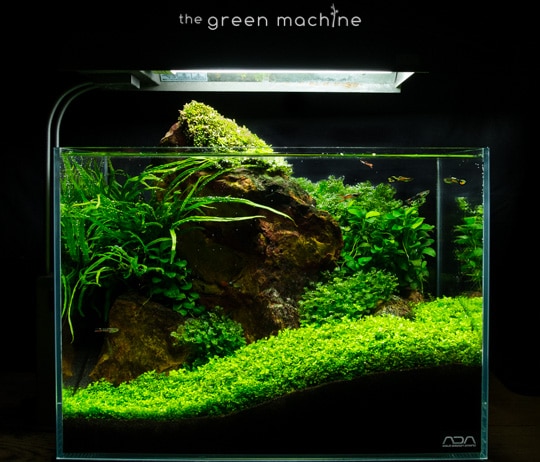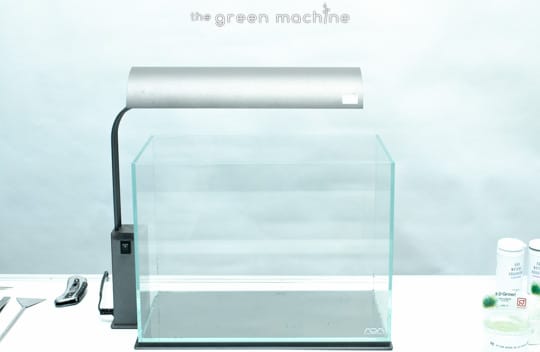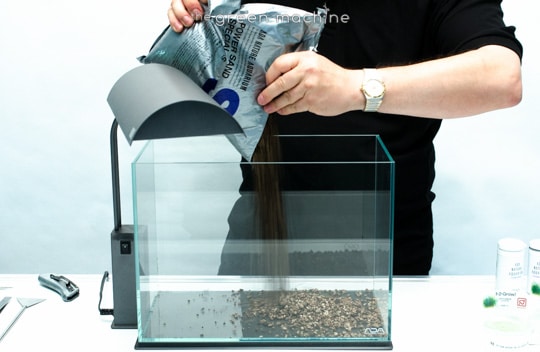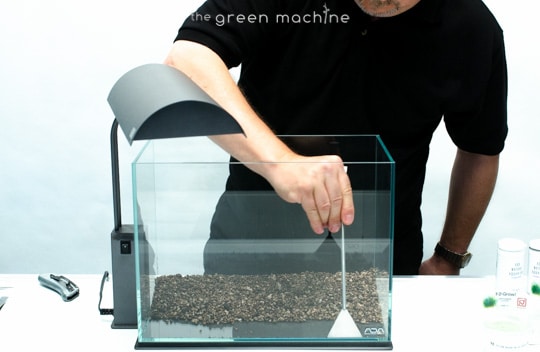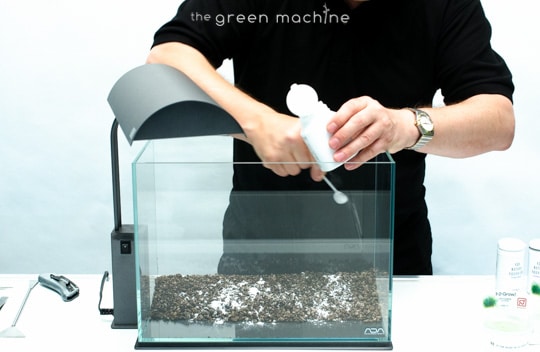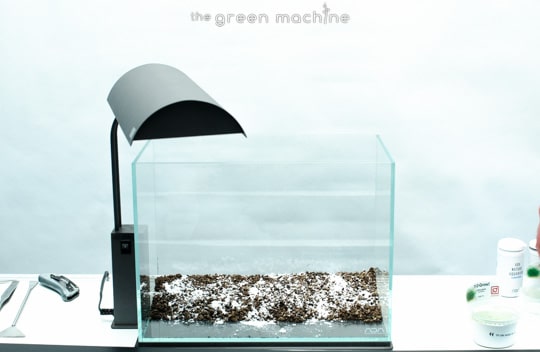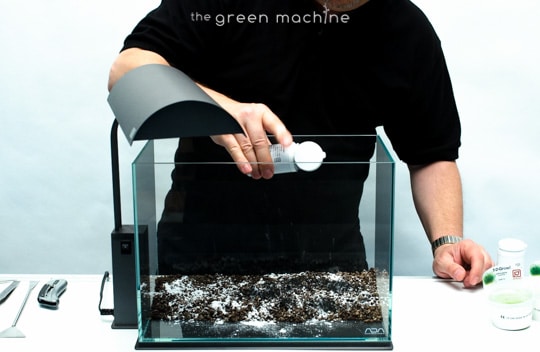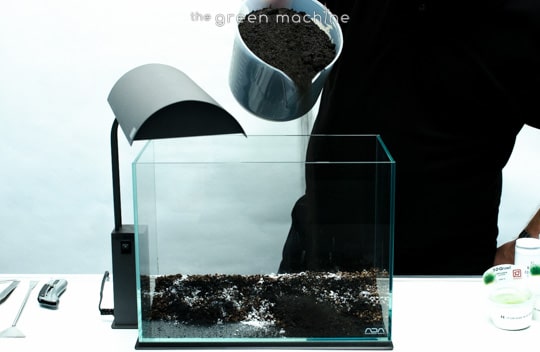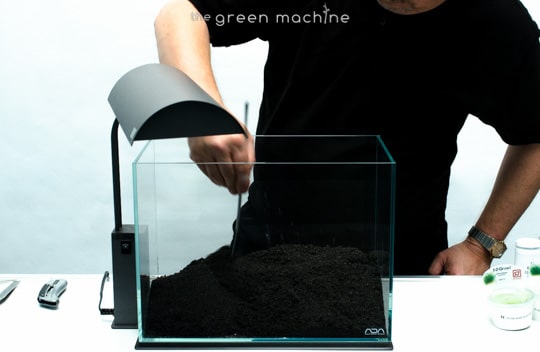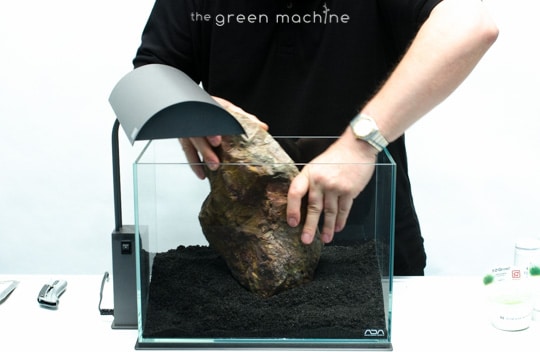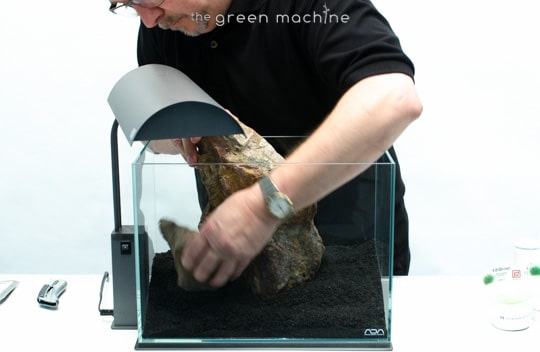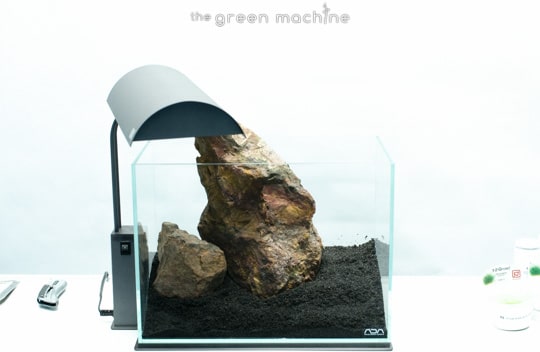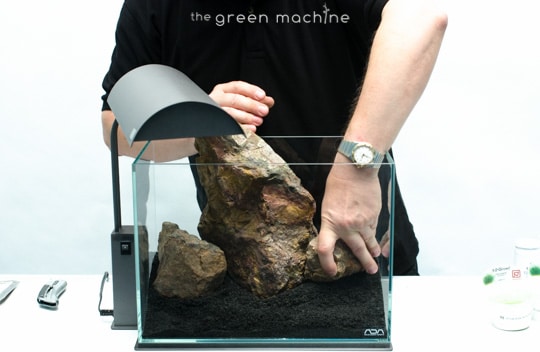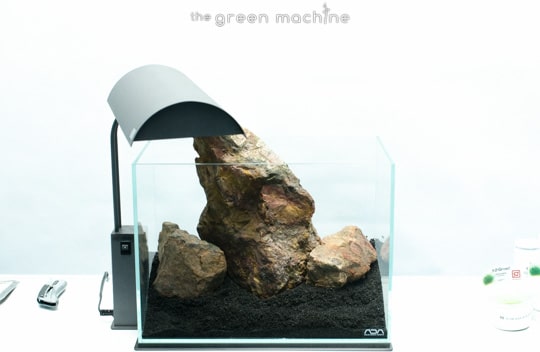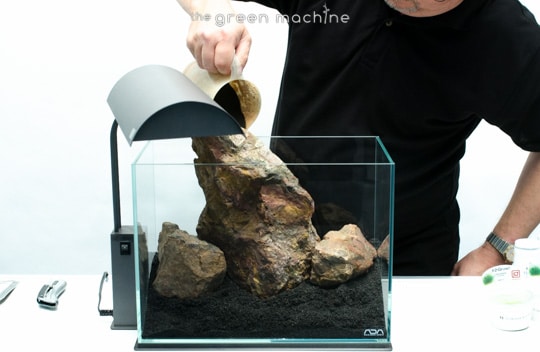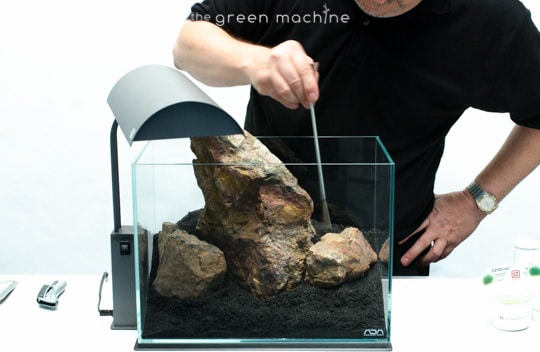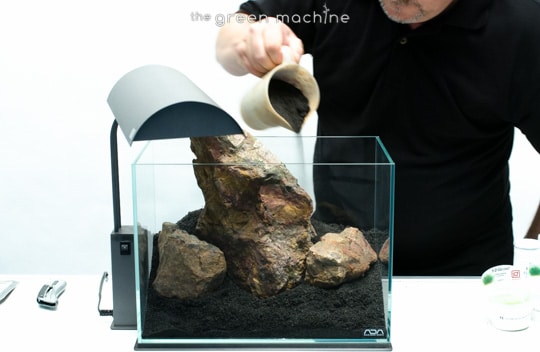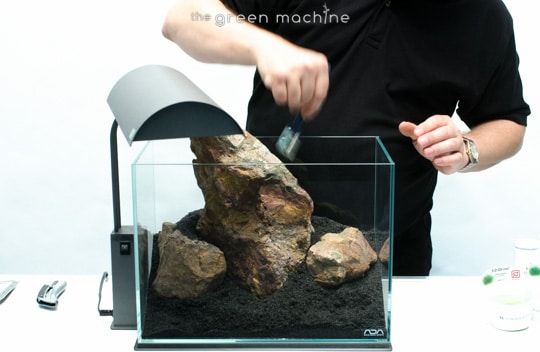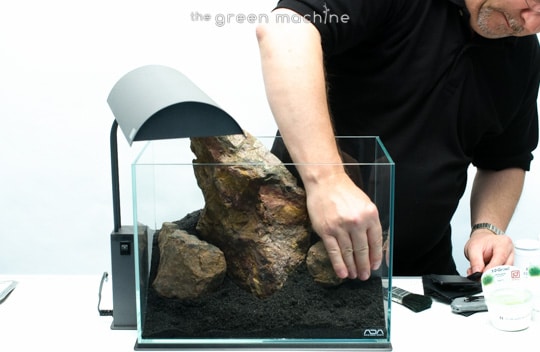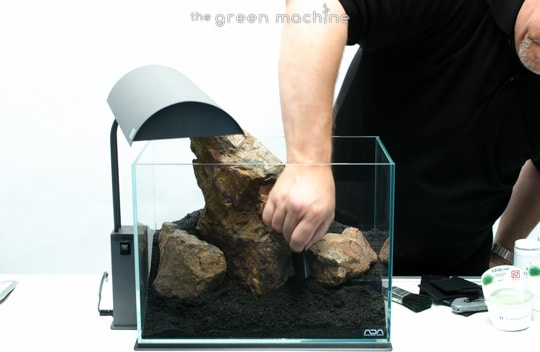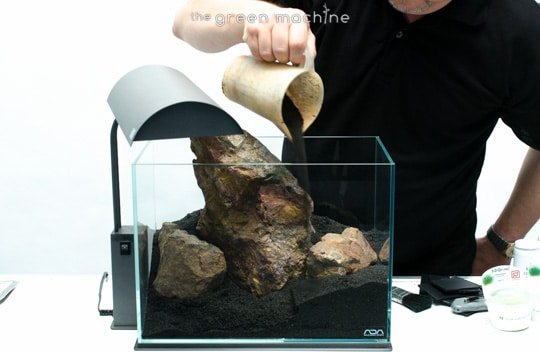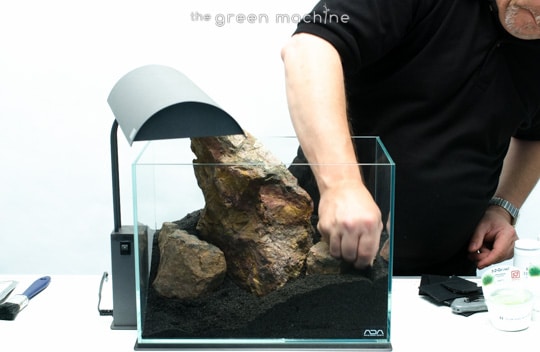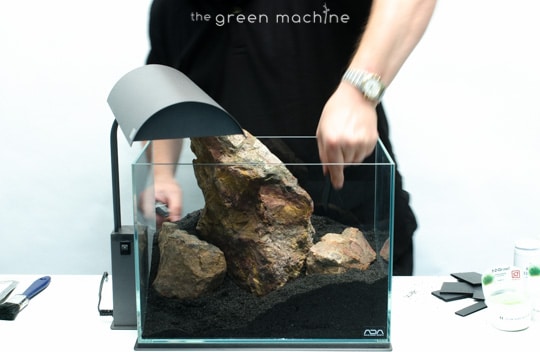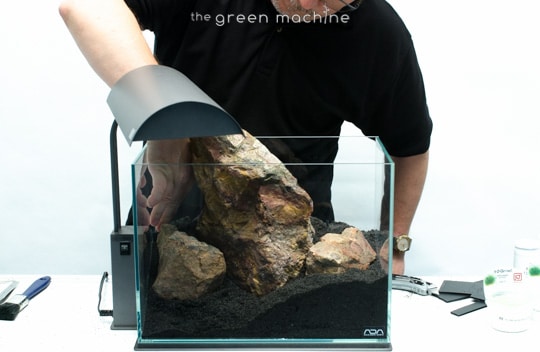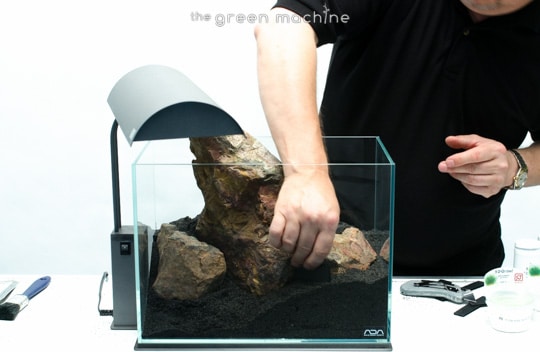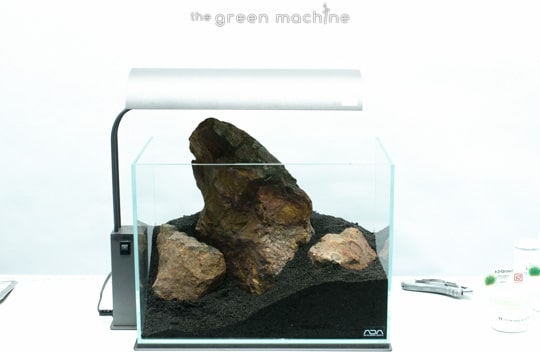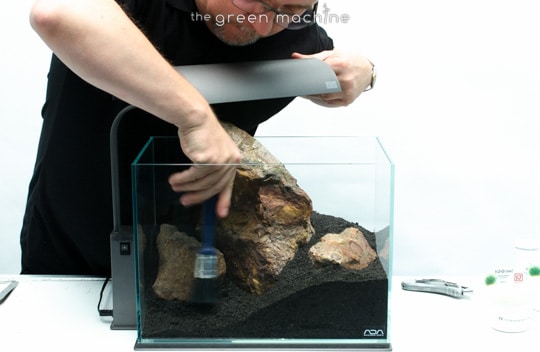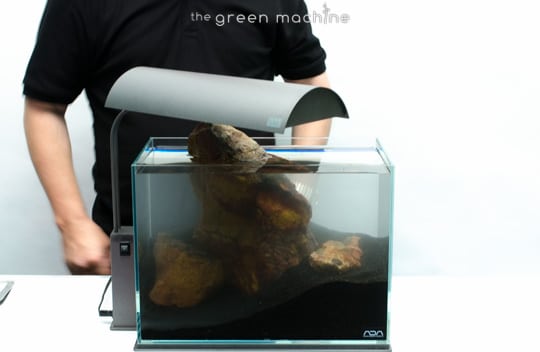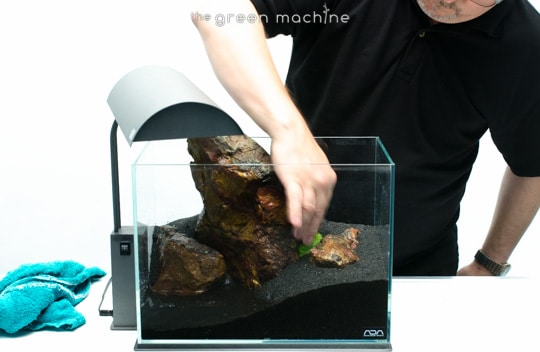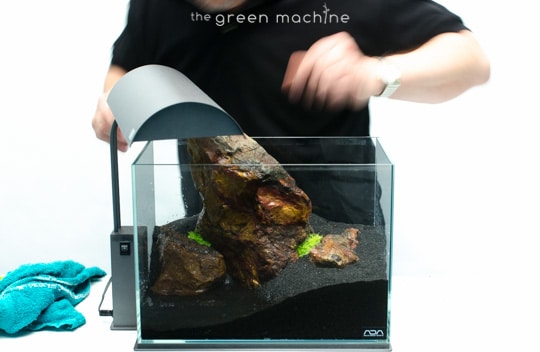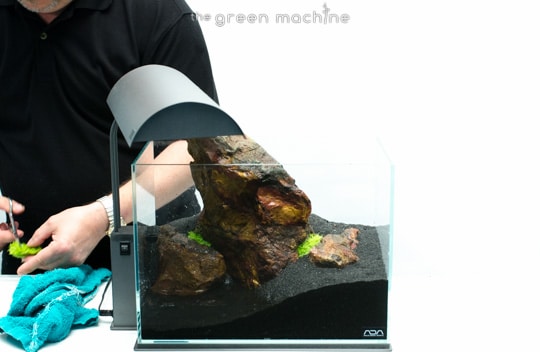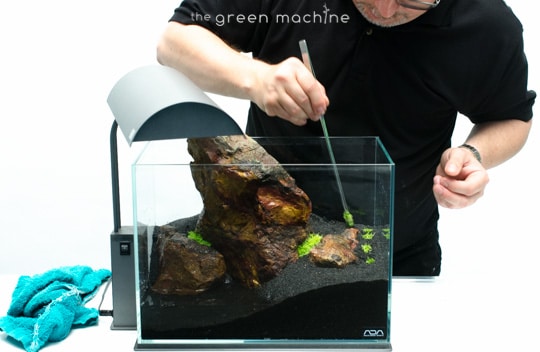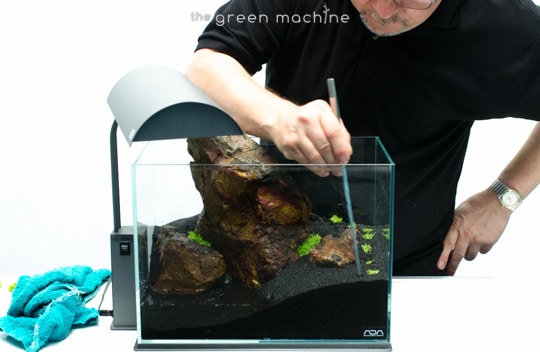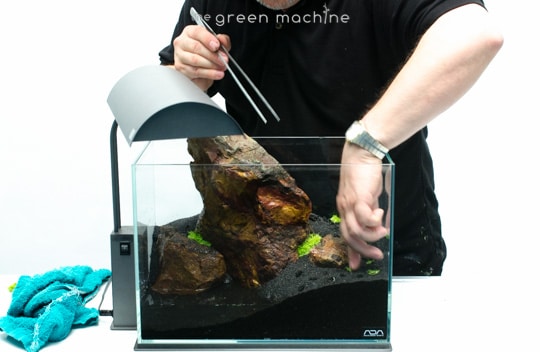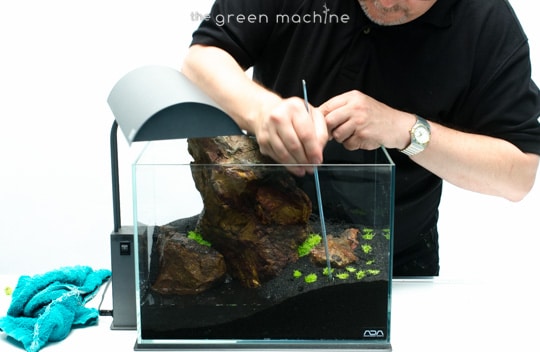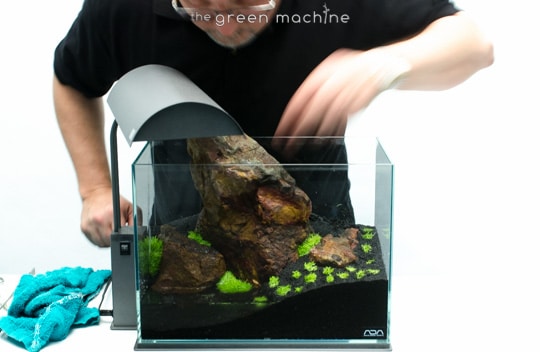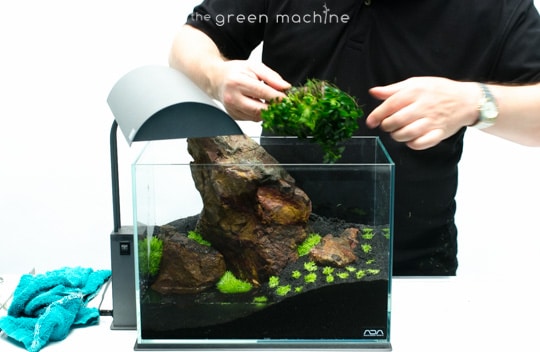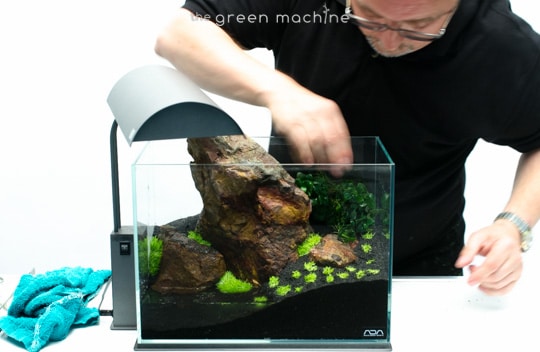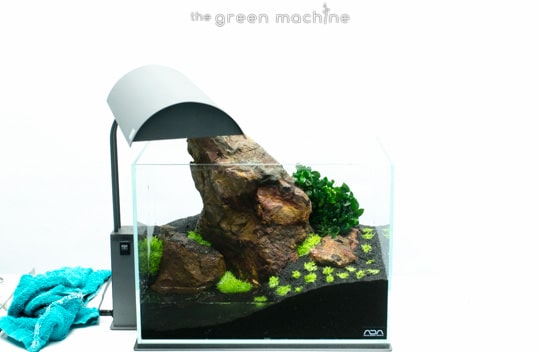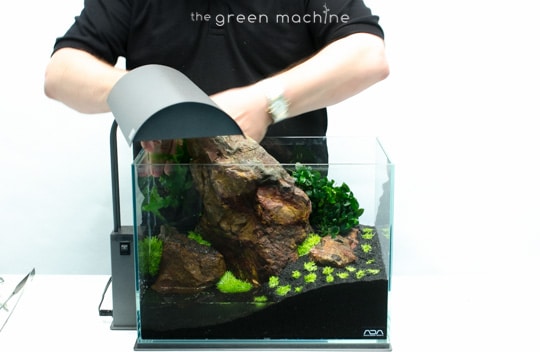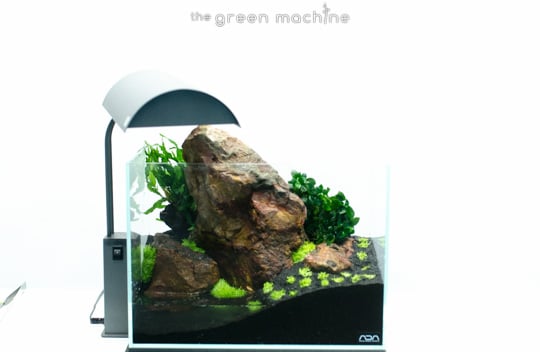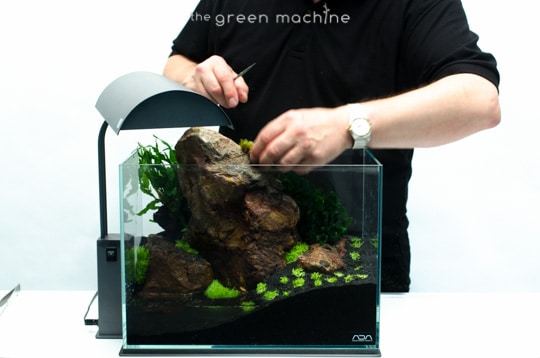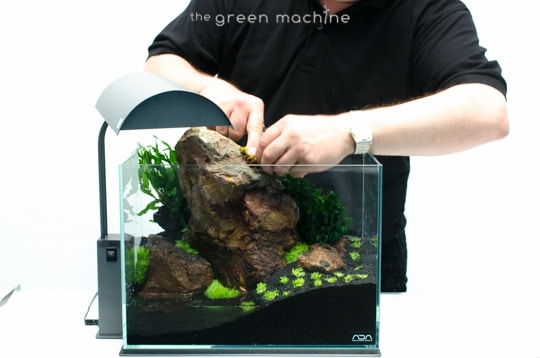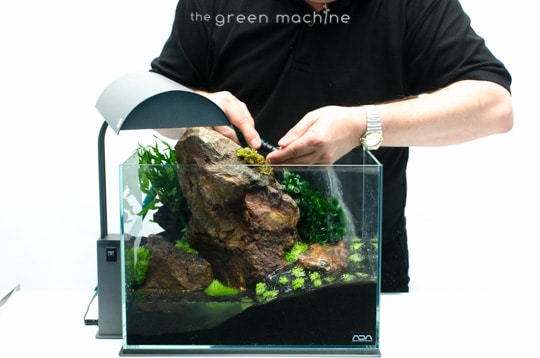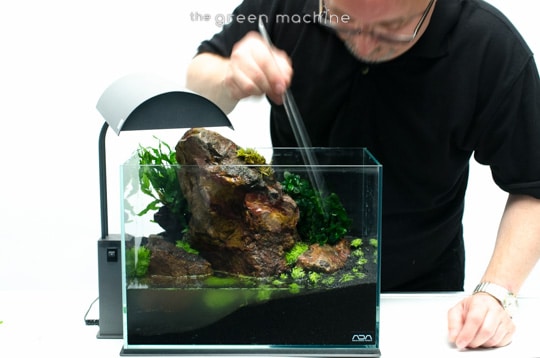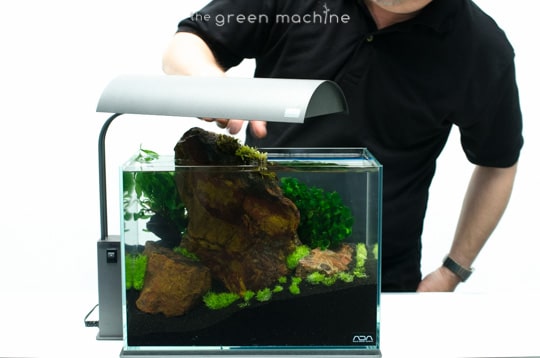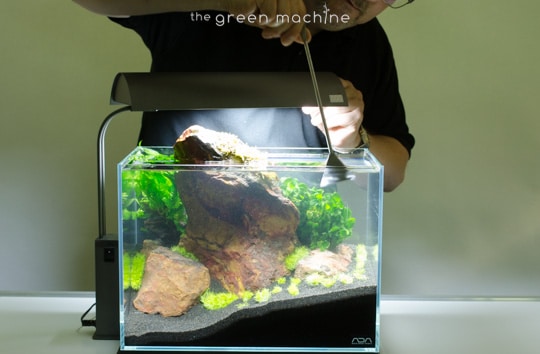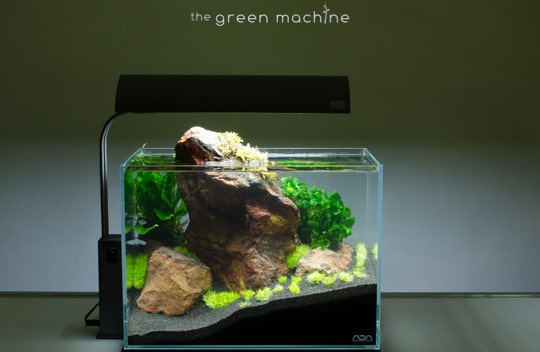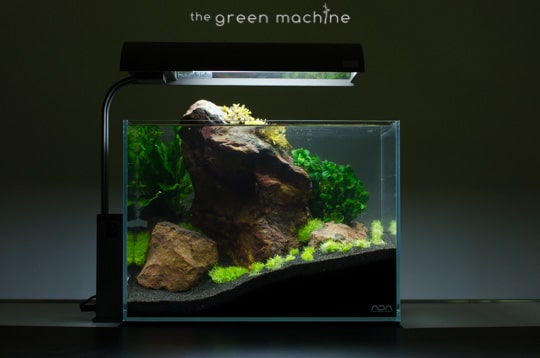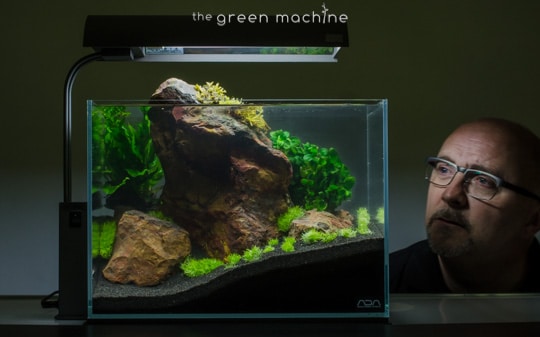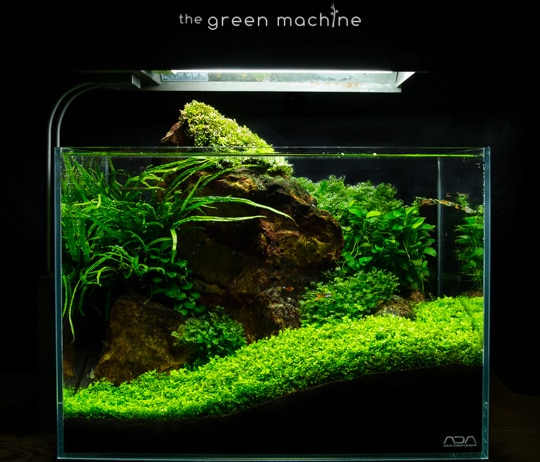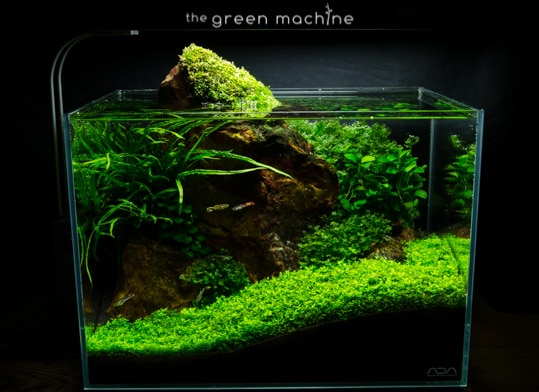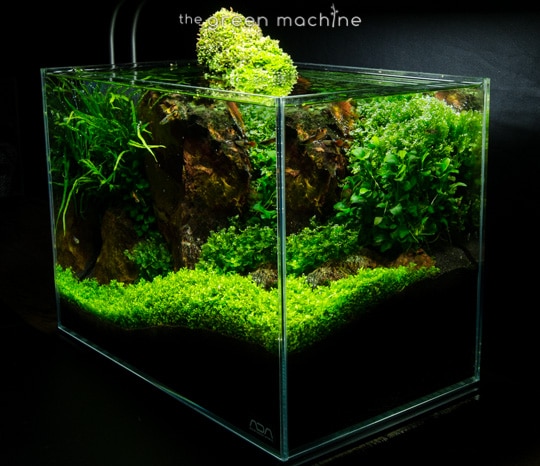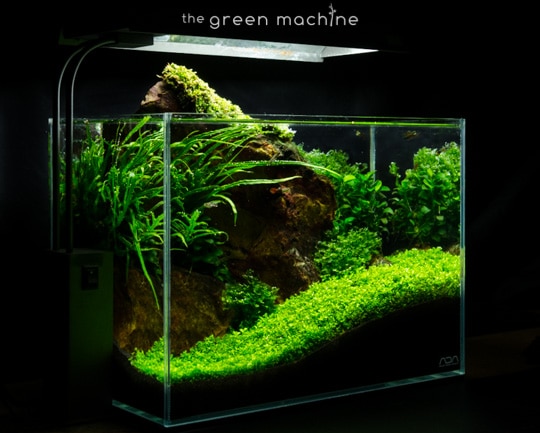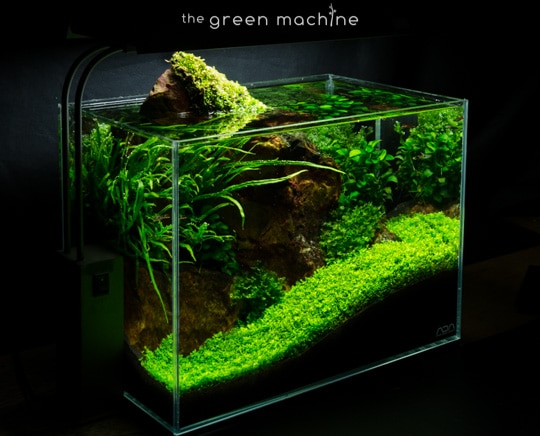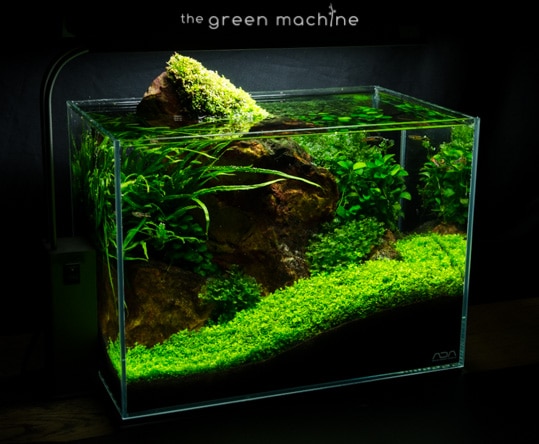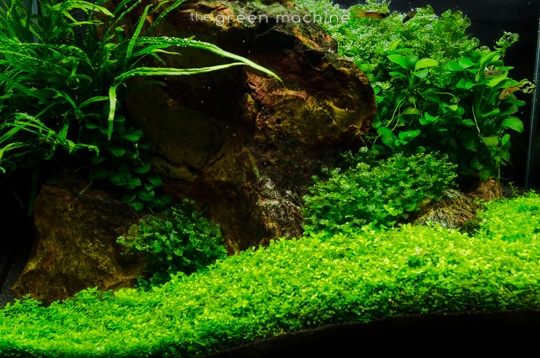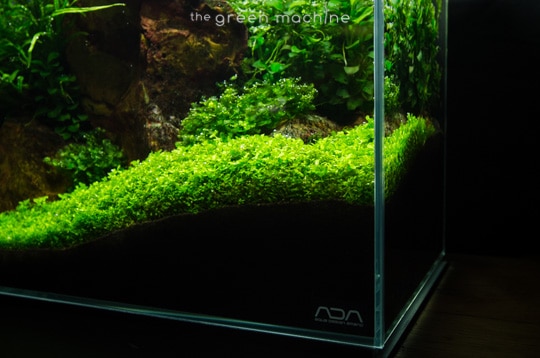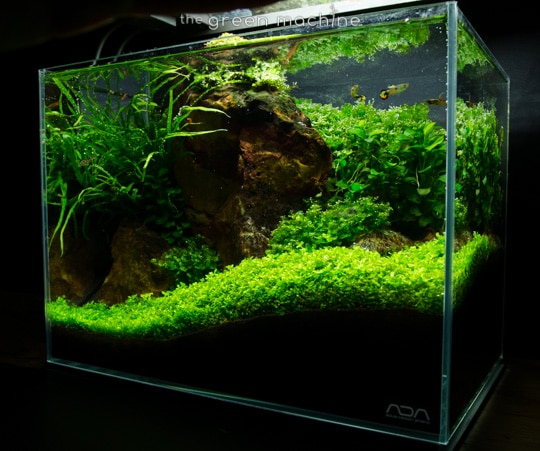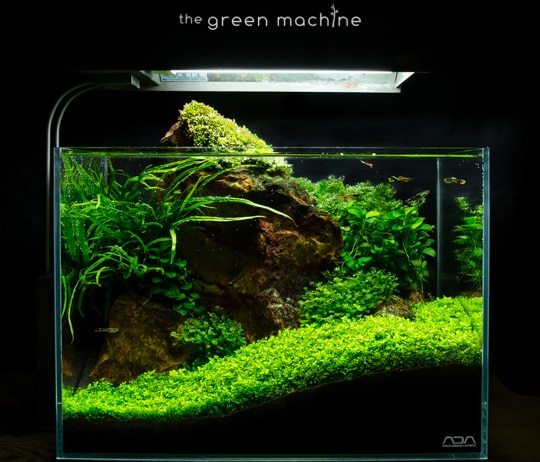
James Findley’s recent nano aquascape for The Green Machine shop gallery. This aquascape journal contains 60 step-by-step photographs, along with a 15 minute video that document the creation of this aquascape.
This is a 15 minute long video documenting the process step by step, along with narration talking through the techniques and concepts involved in the creation of this layout. The video transcript is at the bottom of this page.
Setup Specifications
- Aquarium – ADA Cube Garden Mini M: 36 x 22 x 26cm
- Stand & Lighting – ADA Solar Mini M
- Filtration & Heating – External filter
- CO2 – ADA CO2 Advanced System Black, ADA Drop Checker
- Substrate –
- Decor / hardscape – ADA Sado-Akadama Stone
- Plants –
- Livestock – Endler Guppys
Step by Step…
Click the images to zoOM IN.
The blank canvas…
ADA Power Sand Special S provides a nutrient rich layer in the substrate, ideal for aquatic plants.
ADA Sand Flattener is used to move the substrate layers into James’ desired positions.
ADA Substrate Additives are added to the substrate layer…
ADA Aqua Soil Amazonia is added as the main substrate material- to this day this is still the best aquatic plant substrate that has ever been available to aquascapers.
The primary, or Father stone is added. This is the stunning ADA Sado Akadama stone.
Utricularia graminifolia is added.
A good set of aquascaping pinsettes are essential for planting!
Monosolenium tenerum is added.
Micranthemum ‘Monte Carlo’ is added.
TGM Terrestrial Moss is added.
9 months after planting…
Like this article? Read more like this…
- Arizona Aquascape Journal by James Findley
- Crimson Sky Aquascape by James Findley- Journal
- Aquascaping; A Whole New Dimension (Shallow Aquariums)
- ‘Fallen Tree’ Aquascape by James Findley
- ‘Natures Chaos’ Aquascape by James Findley
- ‘Riverbank’ Aquascape by James Findley
- The Power of ADA – A 60-P Nature Aquarium
- The Power of ADA – An ADA Nature Aquarium
- The Power of ADA – A Do!aqua Nature Aquarium
- + Many more! – Explore our website!
Video Transcript
Red Rock, by James Findley: Script
Welcome back to The Green Machine, the Nature Aquarium Specialist. In this fifteen minute video you will see professional aquascaper, and founder of The Green Machine, James Findley planting a nano aquarium.
0.13
The layout for this aquascape was born from James’ desire to utilise the very latest aquascaping hardscape material available to him: the stunning, natural red Sado Akadama stone from Aqua Design Amano. James designed the whole layout to reflect the beauty of this stone, and so the layout was accordingly entitled ‘Red Rock’, to denote its inspiration.
The nano aquarium used for this layout was a bit of a change for James, who is more accustomed to working on super-tanks to create artworks such as Nature’s Chaos, Reciprocity and Arizona.
00.37
We will now see how this layout was created, before learning more about it’s composition.
00.42
First, the substrate layer is created. Power sand is added to the aquarium first, followed by substrate additives. These help to create an environment in which beneficial bacteria can multiply more rapidly, and prevent anaerobic conditions within the substrate layer. Other additives also help the plants to flourish. Whilst these additives are not essential, James chooses to use them because they reduce maintenance time and achieve perfect results. These additives are only placed in the areas that will be planted, and the Power Sand is purposely kept away from the visible fronts of the aquarium so that it cannot be seen when viewing the aquarium.
01.10
James is using an ADA Solar Mini M lighting system. These lights are highly effective, use very little electricity and are extremely elegant. You may notice how the lamp rotates so the aquarium can be easily accessed for maintenance.
01:39
Now the Aqua Soil Powder is added. The powder is used because it’s small grain size helps to create a sense of scale, which is particularly important in nano aquariums. It also allows small plant roots to penetrate it more easily, leading to faster growth, particularly of carpet plants. A further benefit of the powder type is that it allows small plantlets to be placed into it far more easily, which makes planting easier.
01.57
The Aqua Soil Powder is banked up to create a greater height at the back of the aquarium than at the front. James uses a Sand Flattener to make the task simple.
02.11
Once the substrate is complete the next step is to add the hardscape. The Main or Father stone is added to the layout first, since this will be the main focus of the layout so adding it first ensures that the rest of the layout is formed around the father stone. In this layout the main stone is unusually large for such a small aquarium. James is well known for breaking the conventional rules of aquascaping and Red Rock continues that trend: the main stone was chosen to be dominant – to exhibit the beauty of the unusually coloured Sado-Akadama stone.
2.32
The second stone is placed tactically, as well as aesthetically, to allow the substrate to be banked up at the back of the layout by creating a barrier or dam of stone.
2.50
The third stone is placed in a similar fashion. This is one of the challenges aquascaping provides: the need to think not only in terms of art, but also in terms of construction. The more complex and unusual the layout, the more thought must be given to it’s construction. But, no matter how masterful and ingenious the construction might be, if the layout is not artistically crafted, it will not be beautiful. Combining these two elements is one of the many skills that aquascaping presents and develops.
3.20
Here you can see James positioning a stone, only to re-position it… looking for the most beautiful surface to place at the front of the aquarium where it will be most visible.
3.40
More Aqua Soil Powder is poured onto the stones to fill any small gaps and create a more natural effect, as though the bed of a river has naturally silted around the stones. In the Nature Aquarium we are attempting to re-create the natural world, so small things like this take very little time but help to achieve a beautiful, natural and convincing result.
4.07
TGM Substrate Supports are now added to the aquarium. These are vital in this layout because the substrate is banked up very high at the back of the layout and without the Substrate Supports it would simply roll down to the lowest point, destroying the layout and potentially causing the very large stone to fall forwards, which would be a disaster and risk damaging the aquarium.
This layout needed a large number of Substrate Supports because of the height of the substrate and the size of the main stone which was around 7 kilograms in weight. You can see how important they are by how carefully they are placed into the substrate, and how many are used. They secure the substrate and ensure stability of the layout. TGM Substrate supports are available online.
04.40
You can see how small aquariums represent their own challenges, especially when used with large hardscape – just getting access to the aquarium to create the layout becomes difficult! James believes that the key to creating beautiful layouts is experimentation, which is why he feels that it is important to use all the different forms of aquascaping available – from super-tanks, to shallow tanks like ‘Tributary’ and ‘Crimson Sky’ and nano tanks like this. To see some more of James’ nano works have a look at ‘Triptych’ which encompasses three entirely separate nano aquariums in one work.
5.17
Now you can start to see the overall flow of the layout: the height of the substrate and the stones draws the eye from the back left corner, diagonally across the aquarium to the front right corner and then across the front of the layout to the front left corner. This ensures that the eye is drawn easily across the entire layout, so it is appreciated in all its glory. For more information on the rules of composition and the Golden Ratio visit The Green Machine’s website where you can access their free aquascaping library and read articles on this, and many other topics.
06.25
Water is now added to the aquarium to dampen the substrate which makes it easier to plant into and also to rinse any dust off the stones – this is not essential but in a small aquarium like this it does not take long to fill it up and then empty it. James gently moves the substrate to create a clean, leading line that will emphasise the flow of the composition.
06.42
The planting now commences. Utricularia gramnifolia is the first plant to be added. This is a difficult plant and James was not happy with its development in this layout, so it was later removed and replaced with Micranthemum ‘Monte Carlo’ which provided a beautiful green carpet, with tiny leaves to create a sense of scale within the small aquarium. When working in nano aquariums it is particularly important to create a sense of scale, otherwise the layout will look cramped, unnatural and ugly. As a result, it is often thought that only small stones should be used in them, but this piece demonstrates that a sense of scale can be achieved with big stones, even in small aquariums. When choosing aquarium plants it is important to consider how they will be when they are fully grown. No aquarium plants will remain the same size and form as they are when they are first bought, so bear in mind how they will grow over time.
08.06
Plant preparation is vital as it ensures that your plants will remain healthy and vibrant and succeed in your aquarium. When working with Utricularia gramnifolia, cut it up into small sections before planting and then place each section into the powder type of substrate in a similar form to the shape of the number five on a dice. This will allow the plants to create a healthy, even carpet as soon as possible. A good quality pair of aquascaping pinsettes is essential for planting into substrate- they allow the plants to be gripped easily, without damaging them, and to be placed with precision into the substrate.
09.25
The next plant to be added to the layout is Anubias minima. This specimen is particularly large because it has been grown on by The Green Machine. It is attached to a small piece of bogwood, making it easy to place in the aquarium. The darker green and fullness of this plant compliments the brighter, smaller carpeting plant in the foreground whilst simultaneously helping to create a greater sense of scale by placing lighter colours at the front of the layout and darker colours at the back.
09.50
The third plant added is Microsorum trident. The older leaves are removed from the plant before it is placed in the substrate, to ensure that it is healthy and will grow well. Again, the darker green of this plant creates a sense of scale and distance in the layout.
10.17
Now the layout is complete, although it will not reach its full glory until it is grown in properly.
10.28
Nine months later this layout was filmed again. You can see how the plants have grown in and established, which is a testament to the quality of the substrate, lighting and maintenance on the aquarium. The plants are pearling rapidly, demonstrating their health and vitality.
10.42
As we move out from the layout, the effectiveness of the composition becomes apparent: the large Sado-akadama stone dominates the layout, but the rolling, undulating heights of the substrate draw the eye effectively from one corner of the aquarium to the other.
11.02
Some TGM Terrestrial Moss has been added to the top of the Sado-akadama stone to add an additional element of complexity to the layout. The brighter green of the Micranthemum monte carlo lightens up the layout, in the same way that cosmetic sand can, and compliments the unusual red of the Sado-Akadama stone.
Endler Guppies bring the layout to life: they are small enough to add a delicacy to it, whilst maintaining the sense of scale but their bright markings add a small splash of dynamic colour which is simply stunning.
In many ways, fish are perhaps not the centre piece of a layout, but the final flourish: they add colour, movement and life. When creating a Nature Aquarium choose small fish as these will complement the layout by adding to it, rather than overwhelming it. They give the layout a naturally effortless appearance which is calming, soothing and peaceful.
You can now see how unusual the Sado-akadama stone is: to find a red stone that is entirely natural and of such a delicate and beautiful appearance is a rare thing. It complements the green plants perfectly, enhancing and emphasising their colours. Red and green are opposite colours on the Colour Wheel and therefore complement and enhance each other perfectly.
This nano aquarium bravely, boldly and unashamedly allows the Sado-akadama stone to take centre stage, celebrating the beauty of not only the stone, but also of nature.
It also provided a chance to create a nano layout, which requires a distinct skill set: in nano aquariums a relatively small mistake can be magnified to the extent that the overall layout is compromised. In super-tanks, small mistakes can more easily be lost within the overall composition, but they require the ability to think on a large scale, without losing attention to detail. Both large and small aquariums represent their own challenges and James was keen to continue exploring all forms of aquascaping.
This layout demonstrates how effective small aquariums can be: it would be a common mistake to automatically consider that the larger the aquarium the bigger its impact, but, in fact, this is not always the case. A beautifully composed, well considered, nano layout hidden away in a small corner can have a huge impact on a space and attract a great deal of attention. An added bonus is that they use far less plants and substrate and therefore can be created very economically. If your next adventure into the world of aquascaping might be a nano aquarium then visit The Green Machine’s free online aquascaping library where you can find tips, tricks and articles to help you achieve success.

